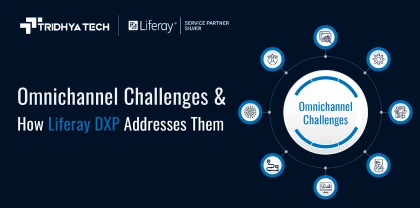Liferay
Liferay DXP Vs. Adobe AEM – A Comprehensive Comparison
 Survival of the fittest always made sense, but more so after the COVID-19 pandemic. The pandemic brought formidable challenges that companies had to handle to sustain themselves and meet increasing customer expectations.
Survival of the fittest always made sense, but more so after the COVID-19 pandemic. The pandemic brought formidable challenges that companies had to handle to sustain themselves and meet increasing customer expectations.
Digital experience platforms like Liferay DXP, Oracle DXP, and Adobe AEM emerged as robust choices for companies to leverage data-driven insights and deliver exceptional digital experiences.
Studies indicate that the global DXP market is expected to reach $3.47 billion by 2030. Things are not as simple as they used to be in the pre-Covid era. Competition existed back then, and customers did expect innovative products and services.
However, the immense surge in online shopping, higher demands for personalization, the complexity of digital channels, and the evolution of technologies like AI and Big Data have contributed to the increased adoption of DXP platforms.
70% of companies are expected to use a composable DXP by 2026. However, the million-dollar question is: Which DXP platform is the best? The market is full of DXP platforms with varying features, capabilities, limitations, and more.
This blog compares two popular DXP platforms, Liferay DXP and Adobe AEM. It may help companies make the right choice for their businesses. Let’s get started.
Table of Contents
- What is Liferay DXP?
- What is Adobe AEM?
- Feature Comparison – Liferay DXP and Adobe AEM
- Capabilities Comparison – Liferay DXP Vs. Adobe AEM
- Benefits Comparison – Liferay DXP Vs. Adobe AEM
- Problems Solving Ability – Liferay DXP Vs. Adobe AEM
- Final Verdict
What is Liferay DXP?
Liferay DXP is an open-source platform designed for enterprises to create, manage, and deliver highly personalized experiences across multiple touch points. It provides the tools to build and manage high-quality websites and facilitates the creation of intranets, customer portals, E-commerce platforms, mobile applications, and more.
Thanks to its modular architecture, powerful theme engine, cloud-native architecture, API-first approach, and pre-built integrations, Liferay DXP is a popular choice for companies to deliver engaging and personalized experiences. With its flexibility and scalability options, Liferay DXP also facilitates robust collaboration, content, and customer engagement for enterprises.
Liferay DXP was showered with praise and accolades at Gartner’s 2024 Voice of the Customer for Digital Experience Platforms report. It received positive recognition and rave reviews from 35 esteemed global companies.
What is Adobe AEM?
Adobe AEM is a robust CMS (content management system) with digital asset management capabilities. It is enterprise-oriented. In addition to content management, Adobe AEM enables enterprises to deliver personalized digital experiences based on user preferences and online behavior.
Whether it’s multiple websites, social media platforms, or apps, Adobe AEM simplifies content management for companies and allows them to focus on other productive tasks. Built on the foundation of Adobe Cloud technology, it facilitates remote access to digital content from any device or location.
Adobe AEM’s powerful tool suite provides the necessary firepower for companies to build engaging websites, manage and process forms, develop text-heavy blog pages and other long-form content, and grab user attention on social media. In short, Adobe AEM provides the flexibility and scalability for companies to fulfill their digital transformation goals.
More than 138,072 websites use Adobe Experience Manager have used Adobe AEM and 33,645 live websites use it currently.
Feature Comparison – Liferay DXP and Adobe AEM
Below is a feature comparison of Liferay DXP and Adobe AEM.
| Feature | Liferay DXP | Adobe AEM |
| Content Management | Robust content modeling, versioning, and workflow capabilities | Strong content management features with a focus on rich media and digital assets |
| Personalization | Provides personalization features based on user behavior and preferences | Provides advanced personalization capabilities, including AI-powered recommendations |
| Community Engagement | Provides built-in community features for forums, blogs, and social interactions | Offers community features but may require additional integrations |
| Digital Asset Management | Includes basic digital asset management capabilities | Provides comprehensive digital asset management features with advanced workflows and integrations |
| Integration | Offers extensive integration capabilities with third-party systems | Integrates seamlessly with other Adobe Experience Cloud products but may require additional connectors for third-party systems |
Capabilities Comparison – Liferay DXP Vs. Adobe AEM
Below is a capabilities comparison of Liferay DXP and Adobe AEM.
| Capability | Liferay DXP | Adobe AEM |
| Scalability | Highly scalable to handle large-scale digital experiences | Scalable but may require additional resources for complex implementations |
| Customization | Provides extensive customization options through its modular architecture | Provides customization options but may be more complex due to its proprietary nature |
| Open-Source vs. Proprietary | Open-source platform with a vast community | Proprietary platform with a strong support network |
| Cost | Community edition is free under the GNU license. Enterprise version has subscription-based packages. Other paid versions include SaaS, PaaS and self-hosted. | Expensive due to its proprietary licensing model. It doesn’t have a free or community edition. |
Benefits Comparison – Liferay DXP Vs. Adobe AEM
Below is a comparison of Liferay DXP and Adobe AEM.
| Benefit | Liferay DXP | Adobe AEM |
| Flexibility | Offers greater flexibility due to its modular architecture and open-source nature | Provides a more integrated experience within the Adobe Experience Cloud |
| Cost-Effectiveness | Generally more cost-effective in the long run due to its open-source licensing model. Paid plans can be more expensive. | May have higher upfront costs but can offer long-term value through its advanced features |
| Community Support | Benefits from a large and active community of developers and users | Offers strong support from Adobe through the Experience League Community but may have limited community involvement compared to Liferay |
| Integration | Offers extensive integration capabilities with third-party systems | Integrates seamlessly with other Adobe Experience Cloud products and non-Adobe products. |
Challenges Solving Ability – Liferay DXP Vs. Adobe AEM
Below is a comparison of challenges that Liferay DXP and Adobe AEM solve.
| Challenge | Liferay DXP | Adobe AEM |
| Complex Content Management | Handles large-scale content management, personalization, and localization. | Provides advanced content modeling, authoring, and management capabilities. |
| Digital Asset Management (DAM) | Provides robust DAM features for storing, organizing, and distributing digital assets. | Offers a comprehensive DAM solution with AI-powered asset management and optimization. |
| Omni-channel Experiences | Creates consistent experiences across various channels (web, mobile, IoT, etc.). | Delivers personalized and consistent experiences across all channels and devices. |
| Personalization and Targeting | Enables personalized content delivery based on user behavior and preferences. | Offers advanced personalization capabilities with AI-driven targeting and recommendations. |
| Integration with Existing Systems | Integrates seamlessly with other enterprise systems (CRM, ERP, etc.). | Provides flexible integration options and APIs for connecting with other systems. |
| Scalability and Performance | Handles high traffic loads and can scale to meet growing demands. | Offers high performance and scalability, supporting large-scale deployments. |
| Security and Compliance | Ensures data security and compliance with industry regulations. | Provides robust security features and compliance with industry standards. |
| Customization and Extensibility | Allows for customization and extension to meet specific business needs. | Offers a flexible architecture and development framework for customization. |
| Community and Support | Active community and extensive support resources available. | Strong community and support network with a wide range of resources. |
Final Verdict
Both Liferay DXP and Adobe AEM have their pros and cons. Liferay DXP is best suited for mid-sized organizations and large enterprises with complex digital needs and a strong focus on customization. On the other hand, Adobe Experience Manager is perfect for companies whose prime focus is on marketing and content management.
Companies can choose the right solutions based on factors like their size and complexity, specific digital needs, budget and resource limitations, and preference for open-source/proprietary software.
Related Blogs
Recent Blogs
-
Future of Mobile Apps in the Car Rental Industry – 2025 and Beyond

-
Why Your Business Needs a Collaboration portal in 2025

-
MuleSoft in Healthcare: Transforming the Patient Management Experience

-
E-Commerce Integrations You Cannot Miss in 2024-25

-
Decode Supplier Management Success with Advanced Vendor Portals























